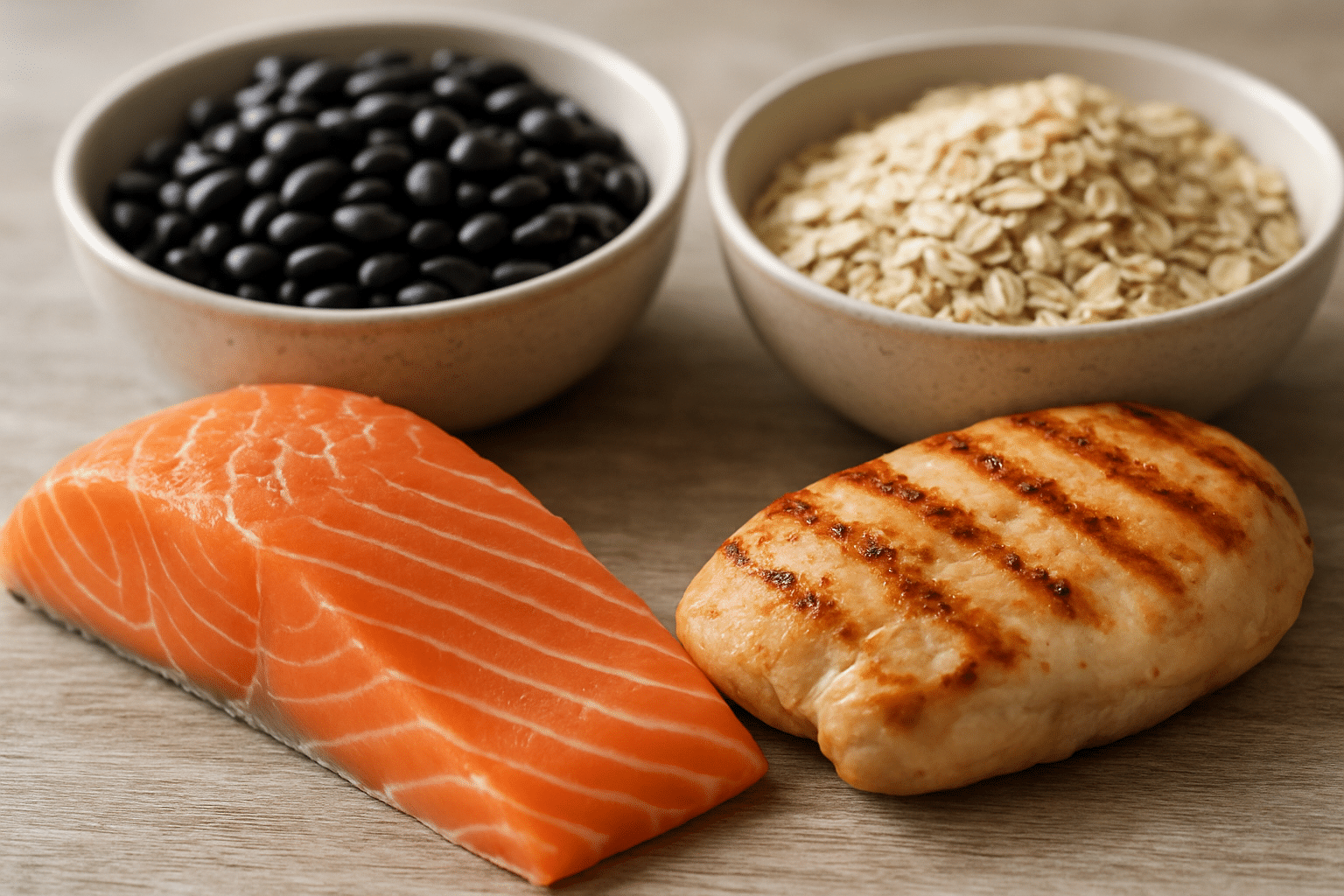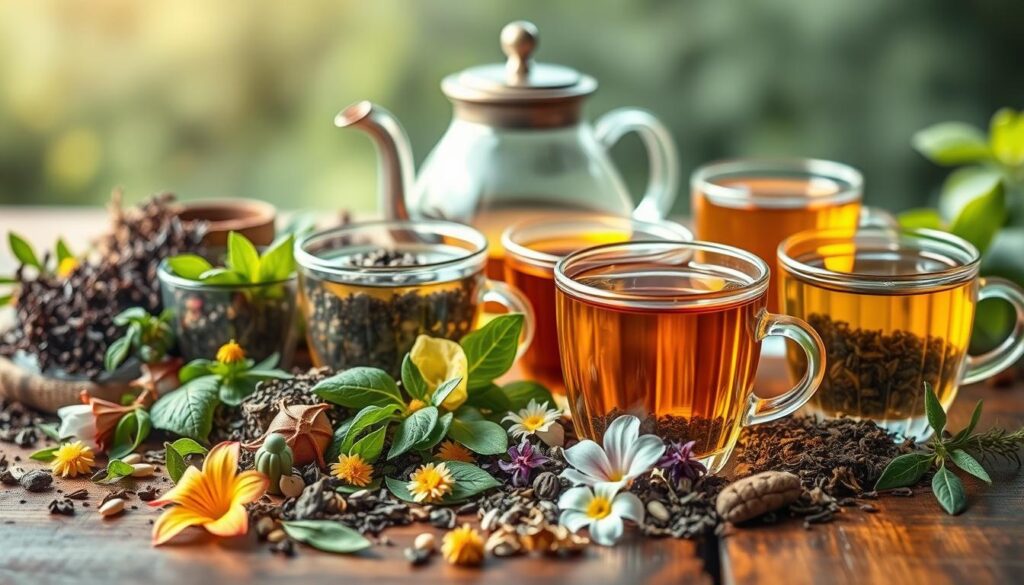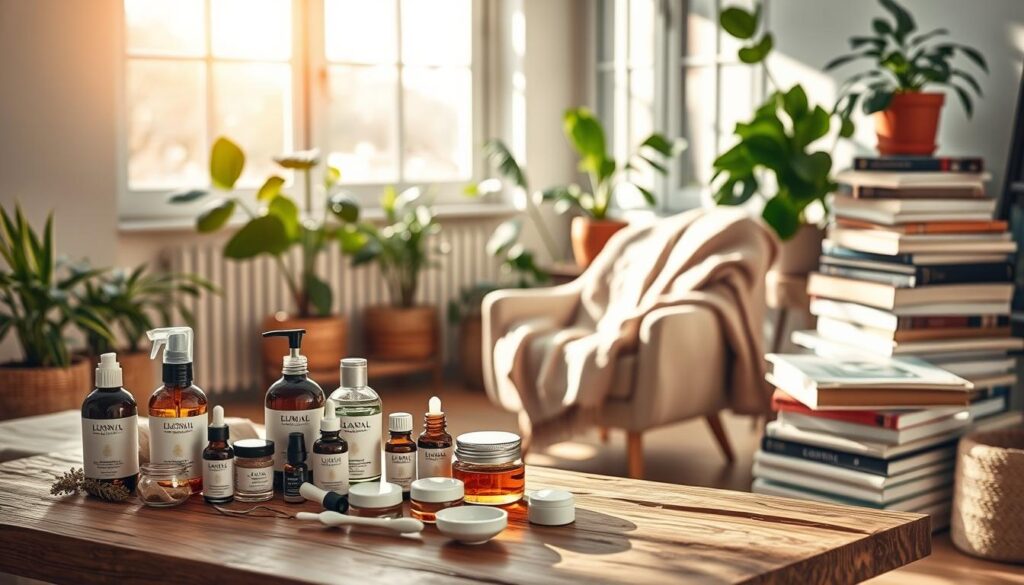What really supports skin and joint health?
Discover how simple cups of tea can support a radiant complexion with tea and boost overall skin health. This guide explains how drinking and using selected herbal blends can reduce inflammation, protect collagen, and add hydration. You’ll learn practical, evidence-informed tips grounded in clinical findings like green tea catechins and anti-inflammatory flavonoids, along with common-sense safety advice such as consulting your clinician about drug interactions.
Across the next sections, we’ll cover how skin-benefiting teas work, the top herbal teas for glowing skin, and targeted options for acne and anti-aging. You’ll also find detox and hydration-focused teas, brewing best practices to maximize benefits, safety and interaction notes, lifestyle habits that complement tea use, and a practical summary to help build a personalized tea plan. Save this guide and use the summary to create a routine that fits a busy U.S. lifestyle.
Key Takeaways
- Natural teas to improve skin can reduce inflammation and support collagen.
- Teas for glowing skin include green tea, chamomile, rooibos, and matcha.
- Herbal teas for skin health may help acne, aging, detox, and hydration.
- Follow brewing best practices to get the most from skin-benefiting teas.
- Check for interactions with medications and consult a clinician when needed.

Natural Foods Rich in Collagen
Understanding How Natural Teas to Improve Skin Work
Natural teas act on skin through three main pathways: neutralizing harmful molecules, calming inflammation, and supporting hydration from within. Each pathway depends on tea type, brewing, and how often you drink it. The following points break down the science behind how teas improve skin and what you can expect when you add them to your routine.
Antioxidants, polyphenols, and skin protection
Many teas, including green, white, rooibos, and hibiscus, contain high levels of antioxidants in tea such as flavonoids and catechins. Green tea’s EGCG has clinical support for preserving collagen and reducing UV-induced damage to skin cells. These polyphenols for skin neutralize free radicals that drive aging, pigmentation, and collagen breakdown.
Regular intake of teas rich in polyphenols for skin can lower oxidative stress markers in the body. That effect links to fewer signs of photoaging and better long-term skin tone when paired with sunscreen and a healthy diet.
Anti-inflammatory compounds that reduce redness and irritation
Chamomile, licorice, and rooibos contain flavonoids, terpenes, and other phytonutrients that act as anti-inflammatory tea compounds. Studies show these compounds can down-regulate pro-inflammatory cytokines such as IL-6 and TNF-alpha.
Oral and topical routes differ in absorption and dose. Drinking calming teas may reduce baseline redness and flare frequency in conditions like rosacea or sensitive skin, while topical extracts deliver higher local concentrations for targeted relief.
Hydration and its role in skin elasticity and texture
Hydration and skin elasticity benefit from steady fluid intake. Teas contribute to daily fluids and some, like hibiscus and rooibos, provide vitamin C and trace minerals that support collagen synthesis and barrier repair.
Teas are not a substitute for topical moisturizers. They complement barrier function by improving nutrient delivery and turgor from the inside when combined with emollients and ceramide-containing products.
Bioavailability varies by tea type, steeping time, and individual metabolism. Most evidence points to modest but meaningful benefits with regular consumption and healthy lifestyle habits.
Top Herbal Teas for Glowing Skin
Natural teas can boost skin health from the inside out. Below are four standout options, each with clear compounds and practical tips to fit into a daily routine. These choices are among the best teas for glowing skin when used consistently and sensibly.
Green tea offers powerful catechins, chiefly EGCG, that protect collagen and lower UV-driven damage. Research finds both topical and oral green tea skin benefits include reduced inflammation, less sebum production, and improved markers of photodamage and acne. Limit intake to about 2–3 cups per day to manage caffeine while still reaping antioxidant effects.
Chamomile contains apigenin and bisabolol, two compounds that calm irritated or eczema-prone skin. Evidence supports chamomile for skin when used in gentle topical formulations, and a mild oral infusion helps reduce inflammation without caffeine, making it a soothing evening beverage.
Rooibos (Aspalathus linearis) supplies aspalathin and nothofagin plus minerals such as calcium, magnesium, and zinc that aid repair and shield skin from oxidative stress. Rooibos antioxidant benefits make it a strong, caffeine-free option for anyone seeking steady support for skin barrier and tone.
Matcha is a concentrated powdered green tea rich in catechins, chlorophyll, L-theanine, and vitamins. Matcha for detox can support liver-related cleansing pathways and provide a high antioxidant yield per serving. Use modest portions to control caffeine and try matcha in lattes or smoothies for a versatile skin-boosting habit.
Pairing these teas with balanced meals and sun protection strengthens results. Rotating green tea, chamomile, rooibos, and matcha helps you enjoy diverse nutrients while staying within safe caffeine limits.
Teas That Target Acne and Blemishes

Some herbal teas can help calm breakouts and support clearer skin when used alongside proven treatments. This section looks at clinical findings, active compounds, and simple ways to add targeted teas into daily habits without replacing dermatologist-prescribed care.
Spearmint and peppermint: hormone-balancing potential
Several small trials found that regular spearmint tea lowered free androgen levels and reduced mild-to-moderate hormonal acne in women. Drinking 1–2 cups daily for several weeks produced measurable changes in some participants.
Peppermint contains menthol and related compounds that may reduce sebum production and offer mild antimicrobial action. Topical peppermint products can sting sensitive skin, so test a small area first or choose oral use when irritation is a concern.
Yerba mate and its antimicrobial effects
Yerba mate is rich in polyphenols and saponins linked to antimicrobial and anti-inflammatory activity. Laboratory studies suggest yerba mate extracts inhibit acne-associated bacteria such as Cutibacterium acnes and help reduce oxidative stress on skin cells.
When brewed as a drink, yerba mate antimicrobial properties may support acne control as part of a broader regimen. People sensitive to caffeine should opt for shorter steep times or decaffeinated varieties.
How to incorporate acne-targeting teas into your routine
Start with a consistent tea routine for acne: aim for 1 cup of spearmint daily and rotate with green tea or rooibos to limit caffeine. Track changes and give any new habit 6–12 weeks to show effects.
Cold-brewed or decaffeinated teas ease stomach sensitivity. Pair internal tea use with topical treatments from a dermatologist, rather than substituting prescription or over-the-counter medications.
| Tea | Key Compounds | Suggested Intake | Notes |
|---|---|---|---|
| Spearmint | Polyphenols; antiandrogen effects | 1–2 cups daily | Shown to lower androgens in trials; useful for hormonal acne |
| Peppermint | Menthol; antimicrobial action | 1 cup daily or topical spot test | Peppermint skin benefits include reduced sebum; topical use may irritate |
| Yerba mate | Polyphenols; saponins; antioxidants | 1 cup daily, or decaf/short steep | yerba mate antimicrobial activity shown in lab studies; supports inflammation control |
| Green tea (rotation) | Catechins; anti-inflammatory | 1 cup daily | Low-caffeine option that complements acne-focused teas |
| Rooibos (rotation) | Minerals; antioxidants | 1 cup daily | Caffeine-free; helpful for balance and skin soothing |
Teas for Anti-Aging and Fine Lines
Natural teas offer gentle, evidence-backed support for aging skin. Regular sipping can supply polyphenols and catechins that protect collagen and fight oxidative stress. Below are focused tips on two standout teas and smart brewing for best results.
White tea comes from minimally processed leaves, which helps preserve high levels of catechins and polyphenols. These compounds inhibit enzymes like collagenase and elastase that break down collagen and elastin. Studies of white tea extracts note improved skin texture and reduced wrinkle formation when applied topically and when consumed as part of a daily routine. Using white tea for skin care, either as a drink or in facial mists, can be a gentle way to reduce fine lines naturally.
Oolong tea sits between green and black tea in oxidation. Its semi-oxidized profile delivers a mix of antioxidants that support skin elasticity and metabolic health. Research suggests oolong benefits for skin may include reduced systemic inflammation through lipid metabolism support. That effect can help the skin by lowering internal stressors that speed visible aging.
To extract the most from anti-aging teas, focus on brewing for antioxidants. Use filtered water around 175–185°F for both white and oolong. Steep white tea for 2–5 minutes and oolong for 3–5 minutes. Avoid boiling water; high temperatures can degrade delicate polyphenols.
Try multiple short infusions for oolong; cup-by-cup steeping releases a steady flow of antioxidants. Matcha lovers should whisk to retain nutrients and drink the whole leaf for concentrated benefits. A squeeze of lemon can boost absorption of certain antioxidants, improving the bioavailability of key compounds.
Simple daily habits help tea work better. Drink a cup mid-morning or after lunch to pair antioxidant intake with metabolic cycles. Combine these beverages with sun protection and topical retinoids when appropriate to create a well-rounded approach to reduce fine lines naturally.
Detox and Clearing Teas for Dull Complexion
Clearing a dull complexion often begins with gentle support for digestion and the liver. Herbal infusions can complement a balanced diet and skincare routine by promoting elimination and reducing low-grade inflammation. Choose modest, regular servings rather than intensive cleanses for the best, safest results.
Dandelion and burdock root
Dandelion tea benefits date back to traditional herbal medicine. Taraxacum officinale contains inulin and bitter compounds that help bile flow and mild diuresis. These actions can ease toxin clearance and support digestion, which may reflect in brighter skin.
Burdock root skin clarity is often linked to Arctium lappa’s polyacetylenes and prebiotic fibers. Burdock can aid elimination and reduce microbial imbalances that contribute to breakouts and a lackluster tone.
Milk thistle
Milk thistle liver support comes from the silymarin complex in Silybum marianum. Silymarin protects hepatocytes and helps regulate phase I and phase II detox enzymes. Improved liver function can lower systemic inflammation and help the body clear hormones and metabolites that affect skin quality.
Safe tea detox practices
Adopt a cautious, evidence-based approach when using detox teas for skin. Short-term use of 2–6 weeks with moderate intake of 1–3 cups per day is typical. Drink plenty of water and avoid blends that include strong laxatives such as senna for long durations.
Before starting herbal detoxes, consult a clinician if you are pregnant, nursing, have liver disease, or take medications. A safe tea detox prioritizes steady habits and medical guidance over rapid, aggressive cleanses.
Teas That Improve Skin Hydration and Barrier Function
Good hydration and a strong barrier keep skin smooth and resilient. Drinking the right blends and using cooled brews topically can support moisture, reduce redness, and help protect collagen. Below are practical notes on compounds to look for, safe use, and how to combine internal tea habits with simple skincare.
Hibiscus: natural humectant properties and vitamin C
Hibiscus is rich in vitamin C and anthocyanins that help with collagen synthesis and antioxidant defense. Studies on topical hibiscus extracts show improvements in skin elasticity and pigmentation, while oral intake delivers antioxidants and supports internal hydration and skin health.
Some people find hibiscus acts like a mild humectant, drawing and holding moisture. Use a cup of hibiscus tea daily or add it to a cool-toner spray to boost topical vitamin C and antioxidant benefits without harsh irritation.
Licorice root: barrier support and moisture retention
Licorice contains glycyrrhizin and glabridin, compounds that calm inflammation and help reduce transepidermal water loss. These effects support the licorice root skin barrier and can assist with brightness and barrier repair.
Because high, chronic doses of glycyrrhizin may affect blood pressure, consider deglycyrrhizinated licorice (DGL) if you plan regular use. Short courses of licorice tea, or occasional sipping, give anti-inflammatory support while limiting systemic risk.
Combining hydrating teas with topical skincare
Pairing tea with moisturizer is simple and effective. Start with a gentle cleanser, then apply a ceramide or hyaluronic acid moisturizer to lock in moisture. Afterward, sip hydrating teas for skin to support internal hydration and skin from the inside out.
Cooled green or chamomile tea can serve as a gentle toner spritz. Prepare small batches, sterilize containers by boiling or using sanitized bottles, and store in the fridge for up to 48 hours. Avoid leaving homemade preparations at room temperature for long periods to reduce bacterial growth.
| Tea | Key Compounds | Primary Benefit | Topical Use |
|---|---|---|---|
| Hibiscus | Vitamin C, anthocyanins | Supports collagen, hydrating teas for skin | Cooled infusion as antioxidant toner |
| Licorice root | Glycyrrhizin, glabridin | Licorice root skin barrier support, reduces TEWL | Spot-soothe compresses; avoid high-dose oral intake |
| Green or Chamomile | Catechins, apigenin | Calming antioxidants; aids internal hydration and skin resilience | Cooled spritz to complement pairing tea with moisturizer |
How to Brew and Prepare Teas for Maximum Skin Benefits
Good brewing brings out skin-supporting compounds and keeps your cup pleasant. Use the right water temperature and steeping times to avoid bitterness and to unlock antioxidants. Small adjustments make a big difference in how to brew tea for skin benefits and in daily enjoyment.
Water temperature and steeping times by tea type
Match the tea to its ideal heat. Below is a clear guide for steeping times for skin-healthy teas. Oversteeping often causes bitterness and can lower tolerability.
| Tea | Water Temp (°F) | Steep Time | Why it matters |
|---|---|---|---|
| Green tea | 175–185°F | 2–3 minutes | Protects catechins and avoids grassy bitterness |
| Matcha | ~175°F | Whisked, instant | Full powder intake; concentrated nutrients and caffeine |
| White tea | 160–185°F | 2–5 minutes | Delicate leaves need lower heat to preserve polyphenols |
| Oolong | 185–205°F | 3–5 minutes | Balanced extraction for flavor and skin-supporting compounds |
| Black tea | 212°F | 3–5 minutes | Robust extraction; best for stewed or milk-based blends |
| Herbal infusions | 212°F | 5–10 minutes | Longer steeps release roots, flowers, and minerals |
Concentration, frequency, and serving size guidelines
Drink with purpose. Aim for 1–3 cups daily for most teas to support the skin. This range balances benefits and comfort.
Matcha is more concentrated. Limit to 1 cup made from about 1 teaspoon of powder to manage caffeine and catechins. For spearmint aimed at hormone-related acne, try 1–2 cups a day. Rooibos, chamomile, and hibiscus can be sipped more flexibly through the day.
Track your total caffeine to stay within safe limits. Use these tea serving size for skin suggestions as a starting point and adjust based on how your body responds.
Enhancing teas with skin-boosting add-ins
Simple add-ins raise nutrient value. Lemon supplies vitamin C and can boost polyphenol absorption when paired with certain teas. Add lemon to warm, not boiling, tea to protect vitamin C.
Raw or local honey gives antimicrobial and soothing benefits. Stir honey into warm tea once the cup has cooled slightly for best enzyme retention. Fresh ginger adds anti-inflammatory compounds and can improve circulation.
Acidic add-ins may affect tooth enamel. Drink acidic blends through a straw when possible and rinse with water afterward to reduce enamel impact. For frequent acidic tea consumption, limit exposure and alternate with neutral options like rooibos.
Potential Side Effects and Interactions to Watch For
Natural teas can support skin health, yet they are not free from risk. Read short notes below to recognize common reactions, avoid dangerous combinations, and protect sleep and recovery by respecting caffeine limits.
Common sensitivities and allergic reactions
Some people experience tea allergies or sensitivity to specific botanicals. Chamomile can trigger reactions in people allergic to ragweed. Peppermint and ginger may cause gastric upset in sensitive stomachs. Topical use of tea-based masks can lead to contact dermatitis for those with delicate skin.
Patch test any topical tea preparation on a small area for 48 hours. Stop use if you notice rash, itching, swelling, or breathing difficulty and seek urgent care for severe reactions.
Interactions with medications and when to consult a clinician
Certain herbs alter drug handling by the body. Green tea may affect anticoagulants such as warfarin and change INR values. Licorice can raise blood pressure and interfere with antihypertensives and diuretics. Milk thistle may modify cytochrome P450 activity, which can change blood levels of drugs metabolized in the liver.
St. John’s wort is a strong CYP inducer and can reduce effectiveness of many prescription medicines. For anyone on chronic prescriptions, pregnant women, or people with heart, liver, or kidney disease, ask a pharmacist or primary care clinician about tea-drug interactions before starting regular therapeutic tea use.
Safe limits for caffeine-containing teas
The U.S. FDA guidance suggests up to 400 mg of caffeine daily is generally safe for healthy adults. Tea caffeine varies: black tea often contains about 40–70 mg per cup, green tea about 20–45 mg, and matcha can be higher per serving depending on powder quantity.
Respect caffeine limits by limiting afternoon and evening intake so sleep and skin repair remain intact. Choose decaffeinated or herbal options for caffeine-sensitive people, pregnant women, and those advised to restrict stimulants.
If you are unsure about reactions, possible tea-drug interactions, or appropriate caffeine limits for your health, consult doctor about tea to get tailored guidance and safe next steps.
Lifestyle Habits That Complement Teas for Better Skin

Pairing a daily cup of skin-supporting tea with simple lifestyle habits boosts results. Small changes in diet, sleep, stress habits, and topical care make tea benefits more noticeable. Use these practical tips to build a routine that supports glow from the inside out.
Nutrition and hydration strategies that boost tea effects
Eat a colorful, anti-inflammatory diet rich in berries, leafy greens, and orange vegetables to support collagen and barrier repair. Foods high in omega-3s, such as salmon and walnuts, help reduce redness and improve texture.
Keep daily water intake steady in addition to tea. Hydration helps skin turgor and aids natural detox pathways. Vitamin C, zinc, and vitamin A work with tea polyphenols to strengthen collagen and speed barrier repair.
Sleep, stress management, and how they interact with tea benefits
Deep sleep triggers growth hormone and cellular turnover. Poor rest raises inflammatory markers and slows recovery. Make sleep a priority for optimal sleep and skin repair and to let tea antioxidants do their job.
Use calming rituals like chamomile or lavender tea in the evening, gentle breathing, or a short mindfulness practice before bed. L-theanine in green tea and matcha can promote calm, but limit caffeine late in the day to protect sleep quality.
Skincare routine tips to pair with internal tea use
Design a simple AM routine: gentle cleanser, antioxidant serum such as vitamin C, moisturizer with ceramides, and broad-spectrum SPF. This protects skin while internal tea nutrients work on repair.
Nighttime: cleanse, apply targeted treatments like a retinoid if appropriate, then a nourishing moisturizer to support barrier restoration. Talk with a dermatologist when combining herbal intake with prescription topicals to avoid interactions.
These combined habits create a lifestyle for better skin that lifts the effect of tea. Focus on nutrition and tea benefits, prioritize sleep and skin repair, practice stress management and skin-friendly routines, and choose skincare to pair with tea for consistent, visible improvement.
Natural teas to improve skin
Start with a quick overview to make choices simple. Below is a concise list of proven tea options and their core benefits, plus a clear way to build a personalized tea plan for skin concerns. Use the short routines to fit tea into a busy day and track results over 6–12 weeks.
Summary list of top teas and primary skin benefits.
- Green tea: antioxidant action, collagen preservation, anti-inflammatory effects.
- Matcha: concentrated catechins for detox support and nutrient density.
- White tea: anti-aging support and collagen protection.
- Oolong: supports skin elasticity and offers metabolic benefits.
- Rooibos: antioxidant-rich, mineral support, naturally caffeine-free.
- Chamomile: soothing and anti-inflammatory for sensitive skin.
- Hibiscus: high in vitamin C, humectant-like brightening effects.
- Spearmint: may help hormone-related acne when used regularly.
- Yerba mate: antimicrobial and antioxidant properties.
- Dandelion, burdock, milk thistle: liver-support teas for complexion clearing.
- Licorice root: barrier support and moisture retention; use cautiously around medications.
How to build a personalized tea plan based on skin concerns.
Identify your main issue: acne, aging, dryness, or sensitivity. Pick two to three compatible teas: one for morning, one for daytime, and a caffeine-free option for evening.
Adjust for caffeine sensitivity and current medications. If you take blood thinners or hormone therapies, check with a clinician before adding strong herbal infusions like licorice or milk thistle.
- Acne-prone, adult hormonal acne: morning green tea, midday spearmint, evening rooibos.
- Dry or mature skin: morning matcha (small serving), afternoon hibiscus, evening chamomile.
- Sensitive or reactive skin: rooibos or chamomile across the day, hibiscus occasionally for vitamin C.
Short daily and weekly tea routines for busy lifestyles.
Keep a simple, repeatable skin-focused tea schedule to form habits without extra effort.
- Busy morning: 8 oz green tea with a squeeze of lemon for an antioxidant boost.
- Midday calm: one cup of spearmint or rooibos to control breakouts or hydrate without caffeine.
- Evening wind-down: chamomile or hibiscus infusion to soothe and support barrier repair.
- Weekly boost: one to two days of milk thistle or dandelion following clinician guidance for short-term detox support.
Tracking and evaluation.
Run a 6–12 week trial of your personalized tea plan for skin. Take photos, note hydration, blemishes, texture, and any reactions. Small, consistent changes often show over two to three months.
| Skin Goal | Morning | Afternoon | Evening | Notes |
|---|---|---|---|---|
| Antioxidant + anti-aging | Green tea (8 oz) | Matcha (small serving) | White tea or rooibos | Limit caffeine if sensitive; rotate hibiscus for vitamin C. |
| Acne control | Green tea | Spearmint | Rooibos | Watch hormonal meds; consult clinician if needed. |
| Dryness + barrier support | Matcha (small) | Hibiscus | Chamomile or licorice (use cautiously) | Combine with topical moisturizer; test licorice for interactions. |
| Sensitivity + calming | Rooibos | Chamomile | Chamomile or rooibos | Gentle, caffeine-free options to avoid flushing. |
| Detox support | Green tea or yerba mate | Dandelion or burdock (1–2x weekly) | Rooibos or chamomile | Short cycles only; consult a clinician before extended use. |
Conclusion
Natural teas can be a valuable, evidence-informed complement to a skincare routine and healthy lifestyle. This conclusion natural teas to improve skin highlights that compounds in green tea, chamomile, rooibos, and other blends help improve skin tone, reduce inflammation, support hydration, and target concerns like acne and aging when used consistently.
Use the teas for healthier skin summary as a practical guide: choose one or two blends that match your goals, follow recommended brewing and serving guidelines, and watch for interactions with medications or caffeine sensitivity. Moderation matters; consult a healthcare provider if you take prescriptions or have chronic conditions.
Actionable radiant skin tea takeaways include tracking changes for 6–12 weeks, combining tea use with a balanced diet, regular sleep, stress management, and a steady topical routine. Small, consistent steps—such as a daily cup of chamomile at night or green tea with breakfast—can add up to healthier, more radiant skin over time for U.S. readers seeking simple, evidence-based habits.



